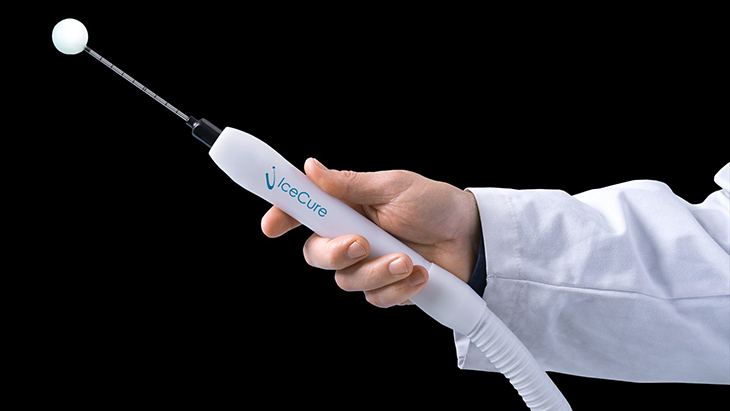
According to a recent study, some individuals diagnosed with breast cancer who are not candidates for surgery to remove tumors may benefit from a minimally invasive cryoablation procedure. This technique has been shown to effectively destroy large tumors in patients who cannot undergo surgical intervention.
Important Points to Remember:
- Cryoablation, a freezing technique, has been found to be 90 percent effective in eliminating breast cancer tumors up to about an inch in diameter.
- This technique is already employed to treat smaller breast cancer tumors in patients who cannot or choose not to undergo surgery.
- Most breast cancer tumors tend to recur when treated solely with radiation and hormone therapy.
A new treatment using extreme cold, known as cryoablation, has shown promise in effectively destroying large tumors in breast cancer patients who cannot undergo surgery. This technique, which involves freezing cancerous tissue, is already commonly employed to eliminate smaller tumors.
Traditionally, cryoablation has been successful in treating tumors less than 1.5 centimeters (cm) in diameter (approximately half an inch). However, researchers aimed to determine its efficacy on larger tumors by studying its impact on patients with an average tumor size of 2.5 cm (about an inch).
At the Interventional Radiology Annual Scientific Meeting, held in Salt Lake City from March 23 to 28, scientists presented their findings. They reported that out of 60 patients who underwent the cryoablation procedure, the cancer recurrence rate was 10 percent at a median follow-up of 16 months. This means that cancer returned in only six patients, indicating a promising outcome for those with larger breast tumors.
“When treated with only radiation and hormonal therapy, tumors will eventually return. So the fact that we saw only a 10 percent recurrence rate in our study is incredibly promising,” Yolanda Bryce, MD, a study leader and an interventional radiologist at Memorial Sloan Kettering Cancer Center in New York City, said in recent a press release.
Dr. Bryce and her team highlight that if tumors recur, patients can undergo cryoablation multiple times to manage and control the tumor growth effectively.
Viable Option For Those Who Can’t Opt for Surgery
Cryoablation therapy involves the insertion of a small needle-like probe into the breast, guided by imaging techniques like ultrasound or computed tomography (CT). This allows an interventional radiologist to precisely locate the tumor and guide the cryoprobe to surround it with a small ice ball, effectively destroying the cancer cells.
According to the study authors, when cryoablation is combined with hormonal therapy and radiation, it can result in the elimination of nearly 100 percent of the tumors. This underscores its potential as a comprehensive treatment option.
While surgical removal remains the standard approach for treating breast cancer, cryoablation offers an alternative for patients who may not qualify for surgery. This could include individuals due to factors such as advanced age, cardiac issues, hypertension, or those concurrently undergoing chemotherapy for another type of cancer. Additionally, some patients may opt against surgery after discussions with breast surgeons, finding cryoablation to be a suitable and less invasive alternative.
“In the past, when treating smaller lesions, we have felt confident that the cryoablation therapy reached the entire ‘kill zone’ of the tumor and a rim of treatment effect outside of malignant tumors,” Lauren Kopicky, DO, a breast surgical oncologist with the Cleveland Clinic in Ohio, said. “With a larger tumor, treatment is more complex, navigating multiple probes to achieve complete tumor ablation and adequately achieve freezing of that target volume.”
Dr. Kopicky, not directly affiliated with the research, views the study’s findings as significant in demonstrating the potential impact of cryoablation on the treatment and management of large tumors.
Cryoablation – Relatively Fast and Painless
The research subjects, all deemed unsuitable for surgery or opting against it, underwent cryoablation as treatment for primary breast cancer between January 2017 and March 2023.
During the procedure, subjects received local anesthesia or minimal sedation. The cryoablation process involved a freeze-thaw cycle: initially freezing for 5 to 10 minutes, followed by passive thawing for 5 to 8 minutes, and concluding with another freezing period at 100 percent intensity lasting 5 to 10 minutes. Patients were discharged on the same day after treatment.
Common side effects of cryoablation include breast pain, swelling, skin discoloration, and in some cases, skin burns. Follow-up imaging was conducted three months post-procedure using mammography and ultrasound, occasionally supplemented with contrast-enhanced mammography or MRI scans.
Dr. Bryce and her team plan to continue monitoring the patient group to gather long-term efficacy data. They aim to further investigate how combining cryoablation with additional therapies like hormone treatment and radiation impacts this particular patient demographic. This ongoing research seeks to refine treatment protocols and enhance outcomes for those undergoing cryoablation for breast cancer.
Pending for FDA Approval
The application of cryoablation for treating cancerous breast tumors remains in the experimental phase.
Presently, the American Society of Breast Surgeons notes that the U.S. Food and Drug Administration (FDA) has sanctioned cryoablation specifically for the treatment of fibroadenomas—solid, noncancerous breast tumors. However, its approval for cancerous breast tumors is pending.
Currently under FDA review is a minimally invasive cryoablation technology intended for early-stage, low-risk breast cancer patients. This ongoing evaluation reflects a potential future approval for broader use in breast cancer treatment.
Dr. Kopicky anticipates that cryoablation will gain wider acceptance and adoption in clinical practice once it receives FDA approval for cancerous breast tumors. This regulatory milestone is expected to pave the way for more extensive utilization and integration of cryoablation as a treatment option for breast cancer patients.
“I think FDA approval will be critical to adopting this technology,” she said. “It’s important for a newly diagnosed cancer patient to consult with their care team, know the recommended standards of treatment, and be informed about what alternative options might be.”



